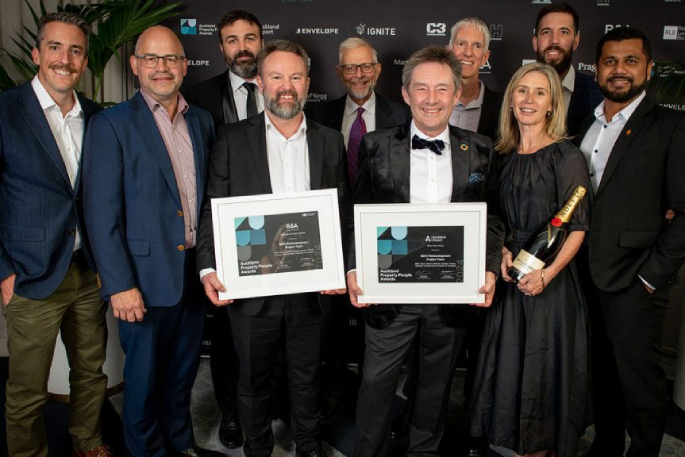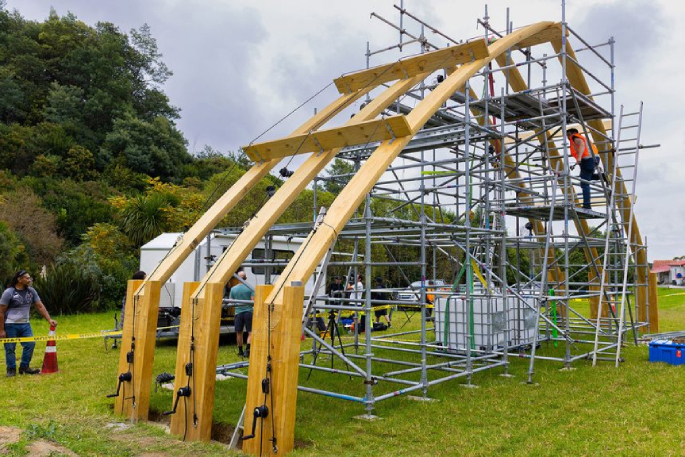B201’s architectural brilliance has been recognised at the 2024 New Zealand Architecture Awards, alongside a project in the Bay of Plenty by Professor Anthony Hōete.
The University of Auckland’s B201 building has come out a winner again, as one of the 23 projects to be recognised as the best of New Zealand’s architecture in 2024.
Te Kāhui Whaihanga New Zealand Institute of Architects’ 2024 awards were announced on November 22 with sustainability an important theme in a number of categories. B201 (Jasmax, with architect Chris Scott) was a winner in the Education section.
One of New Zealand’s most sustainable refurbishments and a world-leading exemplar of low-carbon design, the judges said those creating the building’s design also sought to elevate the mana of Waipapa Marae and the Fale Pasifika, “connecting them confidently into the heart of the campus”.
B201 was described as a highly effective collaboration between Ngāti Whātua Ōrākei, the University and multidisciplinary artists Haumi, and this is evident in the integrated artwork that “appears to prioritise dialogue with place in its acknowledgement of whenua, mana whenua, marae and fale”.
“With exemplary execution of long-pondered masterplan moves, the project masterfully repurposes a tough brutalist structure to transform the cultural precinct, reaching out to connect across and below Symonds Street into the academic heart of the University. In synergy with established street trees, the mesmerising zig-zagging ara moana form of the atrium’s hybrid timber roof structure works impossibly hard to covertly provide light, shade, ventilation and acoustic treatment.”
B201 has received one of New Zealand’s highest-ever Greenstar ratings and its low-carbon design and adaptive reuse aspire to set new benchmarks for sustainable educational environments.
Professor Anthony Hōete (Ngāti Awa, Ngāti Rānana) from the School of Architecture and Planning was also a winner for the University, in two categories, the Small Project Architecture section and the Heritage section for Whare Mīmīrū. Hōete worked with former University staff member Dr Jeremy Treadwell, now at Waikato, for the project.
They used a traditional Māori construction technique, mīmiro, to rebuild a historic Bay of Plenty whare tīpuna (ancestral house), Tānewhirinaki.
Originally constructed in the 1870s on Ōpeke marae, Tānewhirinaki was destroyed in the 7.8 magnitude earthquake of 1931. Despite the iwi salvaging key carvings and preserving them in sheds on the marae for nearly 90 years, three subsequent attempts to rebuild the whare failed due to the loss of mātauranga (knowledge) required for its reassembly.
To address this, the researchers designed a new timber structure using the mīmiro technique, ensuring it met modern earthquake standards. This innovative approach utilised digitally cut timber portals with interlocking compression joints instead of bolts, alongside ropes that were used to pull the structure to the ground like a tent.
Partnerships between architects and mana whenua were well represented in this year’s winners.
“So many projects came from completely different walks of life, but used the vehicle of architecture to explore the potential of partnership between cultural groups. It was epic,” said jury convenor Caro Robertson.
Buildings were lauded for their manākitanga (care), inclusiveness, and sense of history, as well as their efforts in sustainability.
Winners were chosen from a shortlist of 48 outstanding projects and spread across 11 different categories.
They were judged by a panel of architects, including Robertson, co-director of Spacecraft Architects; Ari Stevens, associate at Athfield Architects; educator Julie Stout; and Patrick Kennedy, founding partner of Melbourne studio Kennedy Nolan.
Robertson referred to buildings creating “lovely spaces that are supportive of culture and narratives. These are buildings formed to carry out our daily activities, our work, our play and also our self-expression”.
 Front L to R: Timothy Howarth (Beca), David Doherr (Barnes Beagley Doherr), Matthew Ballard (BBD), Chief Property Officer Simon Neale, Property Services, Rebecca Irwin (Jasmax). Back L to R: Evan Fenwick (Precon Project Management); Alistair Allan, Property Services Project Manager; Tristram Collett, Property Services, Assoc Director Planning and Development; Guillem Ferrer (Hawkins); Sanjay Nand (Hawkins)
Front L to R: Timothy Howarth (Beca), David Doherr (Barnes Beagley Doherr), Matthew Ballard (BBD), Chief Property Officer Simon Neale, Property Services, Rebecca Irwin (Jasmax). Back L to R: Evan Fenwick (Precon Project Management); Alistair Allan, Property Services Project Manager; Tristram Collett, Property Services, Assoc Director Planning and Development; Guillem Ferrer (Hawkins); Sanjay Nand (Hawkins)
Big winner earlier in month
On November 8, the B201 Redevelopment Project Team, the University’s Property Services Team and it partners and collaborators, was crowned the Barker & Associates Supreme Excellence Award Winner 2024, the highest honour at the Property Council of New Zealand’s Auckland Property People Awards, after also winning the Best Team Award.
The judges said the project was groundbreaking in transforming the 50-year-old Human Sciences Building into a cutting-edge 26,500m² educational space. It was celebrated for its exceptional collaboration, commitment to innovation and unrelenting focus on achieving a strong sustainability outcome.



0 comments
Leave a Comment
You must be logged in to make a comment.